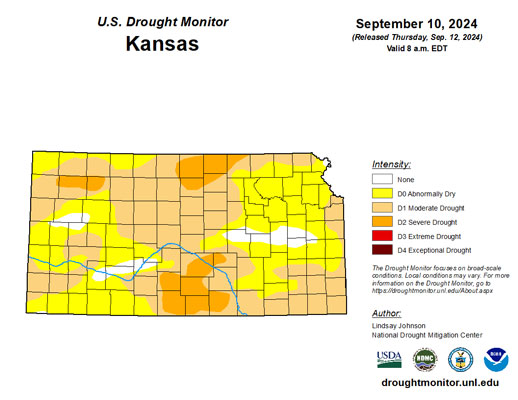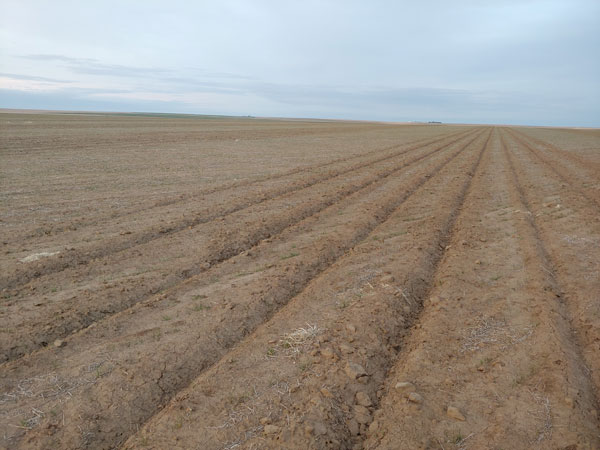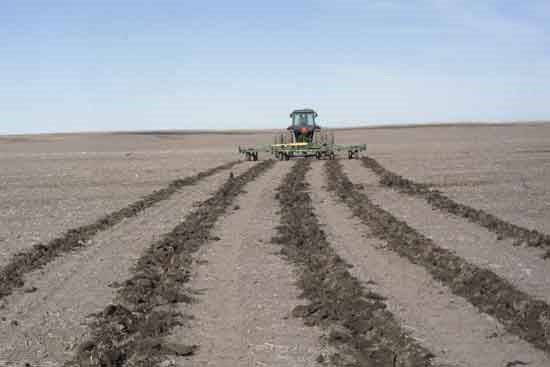Cropland can be quite susceptible to wind erosion under some conditions. Drought conditions may limit vegetative growth and cover. Burning or removing crop residues for forage creates a particularly serious hazard. Winter wheat and other fall-planted crop fields may also be susceptible during periods of low cover before crop establishment after planting. This is particularly true during drought (Figure 1). Marginally productive cropland may not produce sufficient residue to protect against wind erosion. In addition, overgrazed or poorly vegetated rangeland may also be subject to wind erosion.
Recent wind conditions in western Kansas have been conducive to erosion. While this isn’t the time of year when high winds are prevalent, that doesn't mean particularly windy days won’t occur. It is important to monitor field conditions and identify fields in a condition to blow. Such conditions include low vegetation cover and a high proportion of erodible-sized clods (less than 1 mm in size or about the thickness of a dime). It is better to be proactive and treat potential problems before they occur than to react and catch up once a field is eroding. Once soil movement has started, it is difficult to stop further damage completely. However, prompt action may prevent a small erodible spot from damaging an entire field or adjacent fields.

Figure 1. The current Drought Monitor for Kansas.
Emergency control measures
Mulching. If wind erosion has already started, it can be reduced by mulching with manure or other anchored plant materials such as straw or hay. To be effective, at least 1.5 to 2 tons per acre of straw or grass or 3 to 4 tons per acre of corn or sorghum stover are needed to control areas of erosion, and the straw or hay must be anchored. Residue can be spread by hand, spreader, or other mechanical equipment.
A stubble puncher or disk set straight may anchor residue and prevent it from being blown away. Wet manure should be applied at 15 to 20 tons/acre and not incorporated into the soil. Care should be taken not to add wheel paths parallel to the wind direction as the mulch is applied. Traffic areas and wheel paths can contribute to wind erosion.
Mulches are generally practical only for small areas, so they are most effective when applied before the soil starts to move. Producers should scout fields to identify areas that might be susceptible to wind erosion (low vegetation cover and a high proportion of erodible-sized clods less than the thickness of a dime) if they plan to use mulch or manure to control it.
Emergency tillage. Emergency tillage is a last-resort method that can be effective if done promptly and with the right equipment. Emergency tillage aims to make the soil surface rougher by producing resistant clods and surface ridges (Figures 2, 3, and 4). A rough surface reduces wind speed. The larger clods and ridges resist movement and provide traps to catch the moving soil particles.
Chisels with single or only a few tool ranks are frequently used to roughen the soil surface. For emergency tillage, the combination of chisel point size, speed, and depth that produces the roughest surface with the firmest, most resistant clods should be used.
Research has shown that a narrow chisel (2 inches wide) on 24- to 54-inch spacing, operated 3 to 6 inches deep will usually bring enough resistant clods to the surface to control erosion on fine-textured (clay-based) soils. A medium shovel (4 inches wide) can be effective for medium-textured soils (loamy). Spacings should typically be narrower where there is no cover and wider in areas of partial cover, such as a growing crop or plant residue.
If the erosion conditions recur or persist, a second, deeper chiseling should split the first spacing. Tillage passes should be made perpendicular to the direction of the prevailing wind, causing the erosion.

Figure 2. Emergency tillage was used to mitigate wind erosion on a vulnerable field in northwest Kansas. Photo by Jeanne Falk Jones, K-State Research and Extension.

Figure 3. Emergency tillage across 50 percent of the field. Photo courtesy of USDA-ARS Engineering and Wind Erosion Unit, Manhattan, Kansas.

Figure 4. Widely spaced shanks are used for emergency tillage, making clods to roughen the soil surface. Photo courtesy of the University of Nebraska.
If emergency tillage is used in growing crops covered by crop insurance, producers should check with their crop insurance providers regarding emergency tillage insurance rules. Emergency tillage does not significantly reduce wheat yields of an established crop. Studies in southwest Kansas and Manhattan demonstrate that the use of a chisel on 40-inch spacing reduced wheat yields by 5.5 bushels per acre in the emergency tillage area due to direct injury caused by the tillage action. Since the entire field is rarely tilled when performing emergency tillage, the overall yield reduction will be less than 5.5 bushels per acre. The use of emergency tillage can actually increase yields in the untilled portion of the field since that tillage will reduce the amount of damage to wheat caused by wind erosion. The overall reduction in yield for fields that have received emergency tillage has been as little as 1 bushel per acre in the studies mentioned above.
Performing emergency, clod-forming tillage across the field effectively reduces wind erosion. The degree of success of emergency tillage is highly dependent on climatic, soil, and cover conditions. It is often not necessary to till the entire field, but rather, it is very effective to perform emergency tillage passes across 50% of the field (till a pass, leave a pass, repeat). Narrow chisel spacing (20 to 24 inches) is best for this method.
If 50% of the area has been tilled and wind erosion persists, the omitted strips can be emergency-tilled in a second operation to make result in full-cover tillage. If a second tillage pass is needed, it should be at a greater depth than the first pass. Wide-chisel spacings are used in the full-field coverage method. The space between chisel grooves can be chiseled later should wind erosion persist.
All tillage operations should be perpendicular or across the direction of the prevailing or eroding wind. For most of Kansas, an east-west tillage direction is likely best.
The best wind erosion control is created with maximum surface roughness when resistant clods cover a major portion of the surface. Research shows that lower travel speeds of 2 to 3 mph generally produce the largest and most resistant clods. However, speeds of 5 to 7 mph produce the greatest roughness. Because clod resistance is usually reduced at higher speeds, the effect may not be as long-lasting as at lower speeds. Thus, higher speeds are recommended where erosion is already in progress, while lower speeds might be a better choice in anticipation of erosion.
The depth of tillage usually affects clod stability more than travel speed, but the optimum depth is highly dependent on soil conditions (such as moisture level) and compaction. Deeper tillage passes can produce more resistant clods than shallow passes.
If the problem is severe and the wheat has already been destroyed or the ground is bare, chisels 4 to 6 inches wide on a 24- to 30-inch spacing will generally provide enough clods to control erosion. The operating depth should be 4 to 6 inches.
Controlling wind erosion on sandy soils
Loose sandy soils require a different tillage approach to control erosion effectively. Clods cannot be formed at the surface that are sufficiently resistant to erosion on sandy soils. Erosion resistance is achieved by building ridges and furrows in the field to provide adequate protection.
To create sufficient surface roughness, a 14-inch moldboard lister spaced 40 to 50 inches apart (or an 8-inch lister on 20 to 24-inch spacing) is needed. The first listing pass should be shallow, not more than about 4 to 5 inches deep. Then, when additional treatment is needed, the depth should become progressively deeper. Alternatively, for the second treatment, the original ridge may be split.
Adding manure to the ridged surface may also be beneficial in these situations.
Tips for effective emergency tillage
- Watch the weather forecast for periods of high winds, particularly when soils are dry.
- Assess residue and plant cover before the wind blows and take preventive action with emergency tillage. It is much easier to prevent the problem from starting than to stop erosion after it begins. If you wait, the soil only gets drier, and some moisture is needed to form clods.
- Use the combination of tractor speed, tillage depth, and chisel point size to produce the roughest surface with the most resistant clods. If wind erosion is anticipated, do some test tillage before an erosion event to see what tillage tool, depth, and speed will provide adequate clods and surface roughness.
- Always start at the upwind location when the field is blowing. In addition to the area presently blowing, a sufficient area upwind of the eroding spot should be tilled.
- Till in a direction perpendicular to the prevailing wind direction. For row crop areas, it may be necessary to compromise direction and follow the row pattern. Maintain as much anchored stubble in the field as possible.
For more information, see K-State Research and Extension publication MF2206, Emergency Wind Erosion Control, at: http://www.ksre.ksu.edu/bookstore/pubs/MF2206.pdf
DeAnn Presley, Soil Management Specialist
deann@ksu.edu
Tags: soil conservation erosion high winds soil erosion wind erosion emergency tillage